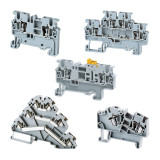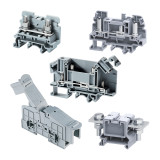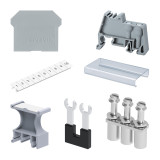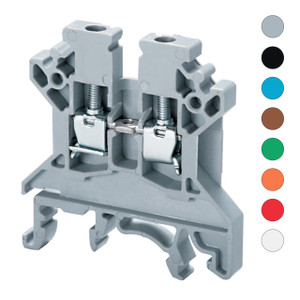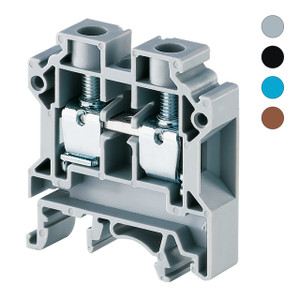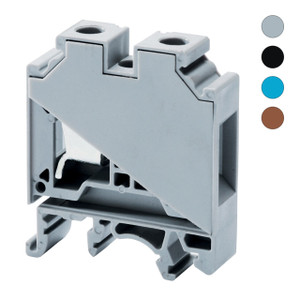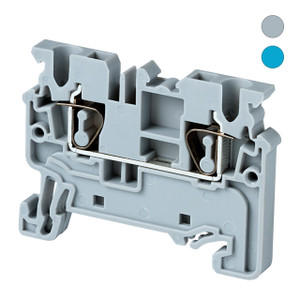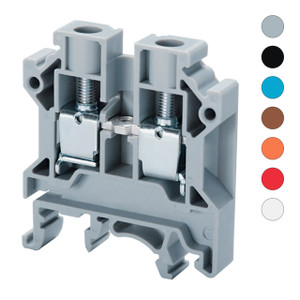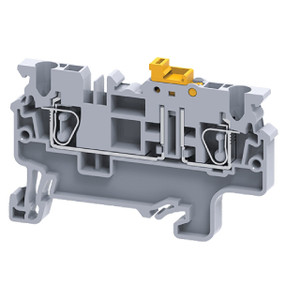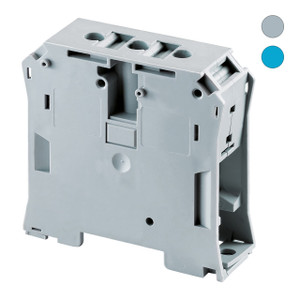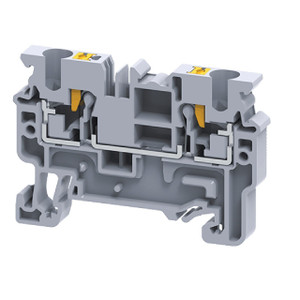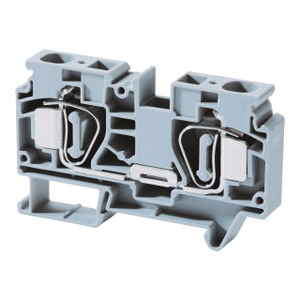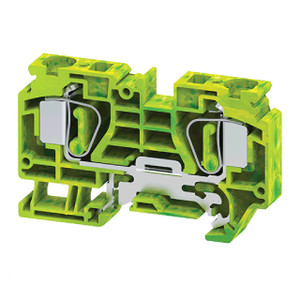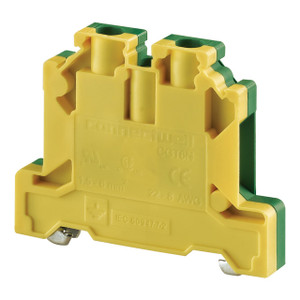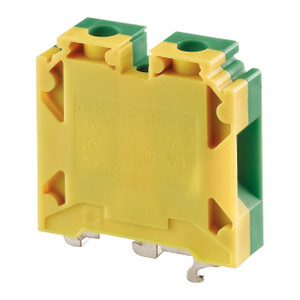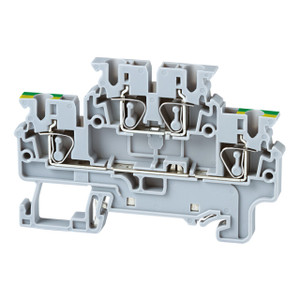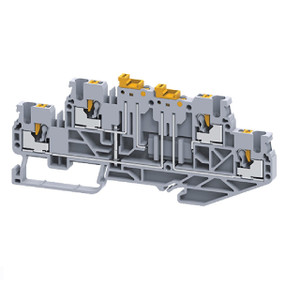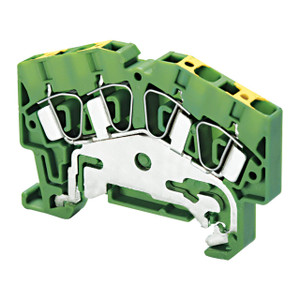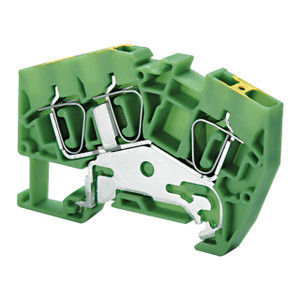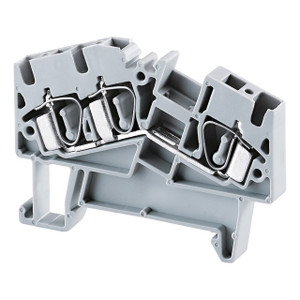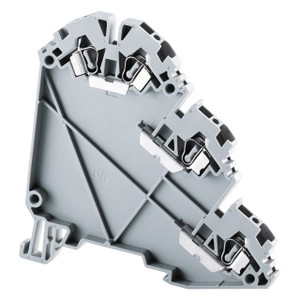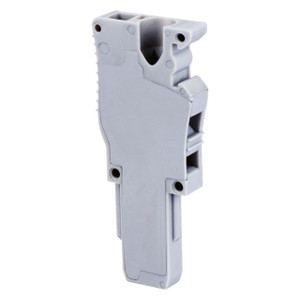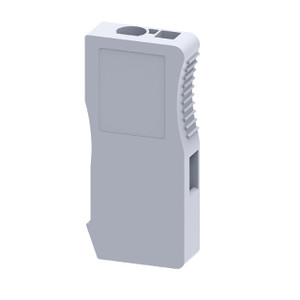DIN Rail terminals
A terminal or terminal block is a connector that terminates a single wire per connection point while connecting it to a circuit, system or other wires. Terminal blocks are available in a number of forms, shapes and sizes, however, they always terminate a single cable per connection point and make use of multiple wire clamps on each terminal to allow multiple connections.
In simplest form a terminal may be of the feed through variety with one incoming and one outgoing wire. Beyond this double level and triple level terminals are used to allow more connections and higher wiring density. We offer up to eight levels of feed through connections and maximum wiring of up to 32 cables in a single marshalling terminal for lower power and signalling applications, with a variety of distribution blocks for higher current requirements. In addition, shorting links are available to allow cross connection between adjacent terminals.
More complex terminals are also available with features such as inline fuses, LED power indication or diode protection against reverse connection.
Terminal blocks are often used in rows either on DIN rails or sometimes as panel mount assemblies; though as previously stated, each terminal clamp only connects to a single wire. Terminals tend to be used in situations that require a permanent connection and are very common in both domestic wiring, commercial and industrial environments. Most control panels will use terminals to connect internal wiring and also to provide a termination point for external connections. For external connections the panel is built with one side of the feed through blocks connected to the internal wiring. When installed on site the installation engineer will connect the on-site wiring to the other side of the feed through connections.
To save space (width) on the DIN rail smaller terminals (those with lower current ratings and smaller wire sizes) will have one side insulated and one side exposed. The second exposed side is insulated by the enclosed side of the adjacent terminal on the DIN rail. At the end of a bank of terminals of the same size the end plate accessory is used to provide insulation to the exposed side. Larger terminals usually 16mm2 and higher will usually have both sides fully insulated and not require the end plate. This is because there are usually less large terminals in a control panel so the small space saving is not important.
At Techna we offer many types of Terminal Blocks as you can see below.
A terminal or terminal block is a connector that terminates a single wire per connection point while connecting it to a circuit, system or other wires. Terminal blocks are available in a number of forms, shapes and sizes, however, they always terminate a single cable per connection point and make use of multiple wire clamps on each terminal to allow multiple connections.
In simplest form a terminal may be of the feed through variety with one incoming and one outgoing wire. Beyond this double level and triple level terminals are used to allow more connections and higher wiring density. We offer up to eight levels of feed through connections and maximum wiring of up to 32 cables in a single marshalling terminal for lower power and signalling applications, with a variety of distribution blocks for higher current requirements. In addition, shorting links are available to allow cross connection between adjacent terminals.
More complex terminals are also available with features such as inline fuses, LED power indication or diode protection against reverse connection.
Terminal blocks are often used in rows either on DIN rails or sometimes as panel mount assemblies; though as previously stated, each terminal clamp only connects to a single wire. Terminals tend to be used in situations that require a permanent connection and are very common in both domestic wiring, commercial and industrial environments. Most control panels will use terminals to connect internal wiring and also to provide a termination point for external connections. For external connections the panel is built with one side of the feed through blocks connected to the internal wiring. When installed on site the installation engineer will connect the on-site wiring to the other side of the feed through connections.
To save space (width) on the DIN rail smaller terminals (those with lower current ratings and smaller wire sizes) will have one side insulated and one side exposed. The second exposed side is insulated by the enclosed side of the adjacent terminal on the DIN rail. At the end of a bank of terminals of the same size the end plate accessory is used to provide insulation to the exposed side. Larger terminals usually 16mm2 and higher will usually have both sides fully insulated and not require the end plate. This is because there are usually less large terminals in a control panel so the small space saving is not important.
At Techna we offer many types of Terminal Blocks as you can see below.
-
-
-
£2.08 inc. VAT£1.73 ex. VAT
-
£1.36 - £1.76 inc. VAT£1.13 - £1.47 ex. VAT
-
£1.07 - £2.14 inc. VAT£0.89 - £1.78 ex. VAT
-
£0.24 - £0.47 inc. VAT£0.20 - £0.39 ex. VAT
-
£0.28 - £0.49 inc. VAT£0.23 - £0.41 ex. VAT
-
£0.68 - £0.78 inc. VAT£0.57 - £0.65 ex. VAT
-
£0.98 - £1.07 inc. VAT£0.82 - £0.89 ex. VAT
-
£1.58 - £1.79 inc. VAT£1.32 - £1.49 ex. VAT
-
£2.06 - £2.20 inc. VAT£1.72 - £1.83 ex. VAT
-
£0.36 - £0.73 inc. VAT£0.30 - £0.61 ex. VAT
-
£0.49 inc. VAT£0.41 ex. VAT
-
£0.00 - £0.58 inc. VAT£0.00 - £0.48 ex. VAT
-
£8.54 - £9.80 inc. VAT£7.12 - £8.17 ex. VAT
-
£3.14 inc. VAT£2.62 ex. VAT
-
£1.57 inc. VAT£1.31 ex. VAT
-
£2.45 inc. VAT£2.04 ex. VAT
-
£3.01 inc. VAT£2.51 ex. VAT
-
£1.88 inc. VAT£1.57 ex. VAT
-
£2.11 inc. VAT£1.76 ex. VAT
-
£0.00 - £12.16 inc. VAT£0.00 - £10.13 ex. VAT
-
£0.70 inc. VAT£0.58 ex. VAT
-
£0.56 inc. VAT£0.47 ex. VAT
-
£0.74 inc. VAT£0.62 ex. VAT
-
£1.44 inc. VAT£1.20 ex. VAT
-
£11.56 inc. VAT£9.63 ex. VAT
-
£1.91 inc. VAT£1.59 ex. VAT
-
£2.36 inc. VAT£1.97 ex. VAT
-
£1.51 inc. VAT£1.26 ex. VAT
-
£1.61 inc. VAT£1.34 ex. VAT
-
£2.26 inc. VAT£1.88 ex. VAT
-
£3.14 inc. VAT£2.62 ex. VAT
-
£2.26 inc. VAT£1.88 ex. VAT
-
£4.30 inc. VAT£3.58 ex. VAT
-
£0.86 inc. VAT£0.72 ex. VAT
-
-
-
£2.39 inc. VAT£1.99 ex. VAT
-
-
£0.56 inc. VAT£0.47 ex. VAT
-
£0.73 inc. VAT£0.61 ex. VAT
-
-
-
£2.88 inc. VAT£2.40 ex. VAT
-
£5.93 inc. VAT£4.94 ex. VAT
-
£1.51 inc. VAT£1.26 ex. VAT
-
£3.11 inc. VAT£2.59 ex. VAT
-
£1.55 inc. VAT£1.29 ex. VAT
-
£0.98 inc. VAT£0.82 ex. VAT
-
£1.50 inc. VAT£1.25 ex. VAT
-
£2.12 inc. VAT£1.77 ex. VAT
-
£2.35 inc. VAT£1.96 ex. VAT
-
£4.78 inc. VAT£3.98 ex. VAT
-
£6.68 inc. VAT£5.57 ex. VAT
-
£0.85 inc. VAT£0.71 ex. VAT
-
£9.41 inc. VAT£7.84 ex. VAT
-
£1.44 inc. VAT£1.20 ex. VAT
-
£1.25 inc. VAT£1.04 ex. VAT
-
£3.02 inc. VAT£2.52 ex. VAT
-
£3.30 inc. VAT£2.75 ex. VAT
-
£3.16 inc. VAT£2.63 ex. VAT
-
£4.39 inc. VAT£3.66 ex. VAT
-
£3.19 inc. VAT£2.66 ex. VAT
-
-
£7.79 inc. VAT£6.49 ex. VAT
-
£8.18 inc. VAT£6.82 ex. VAT
-
-
-
-
-
-
-
£0.74 inc. VAT£0.62 ex. VAT
-
£1.01 inc. VAT£0.84 ex. VAT
-
-
-
£2.39 inc. VAT£1.99 ex. VAT
-
-
-
£2.26 inc. VAT£1.88 ex. VAT
-
£0.66 inc. VAT£0.55 ex. VAT
-
SKU: TtecCX2.5/4
Spring Clamp Terminal for 2.5mm² wire - 4 Connections, 1000V/24A as per IEC60947-7-1
£0.85 inc. VAT£0.71 ex. VAT -
£2.36 inc. VAT£1.97 ex. VAT
-
£0.96 inc. VAT£0.80 ex. VAT
-
£1.22 inc. VAT£1.02 ex. VAT
-
£0.54 inc. VAT£0.45 ex. VAT
-
£0.88 inc. VAT£0.73 ex. VAT


